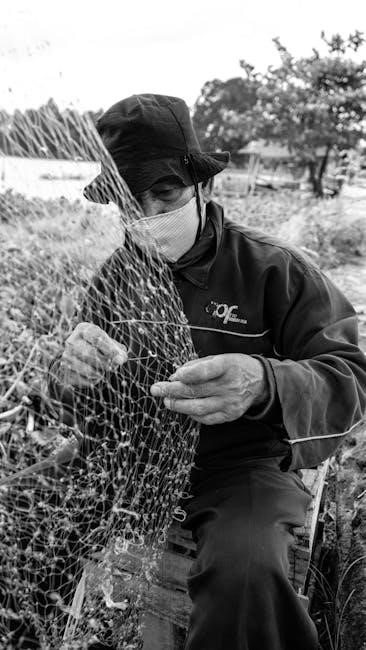The Old Man and the Sea is a timeless tale of perseverance, exploring the struggle between humanity and nature through Santiago’s journey. The novella captures themes of isolation, pride, and resilience, resonating deeply with readers worldwide;
1.1 Overview of “The Old Man and the Sea”
The Old Man and the Sea is a novella by Ernest Hemingway, recounting the journey of Santiago, an aging Cuban fisherman, and his epic battle with a giant marlin. The story unfolds in the Gulf Stream, where Santiago, after 84 days without a catch, ventures far out to sea. Despite his solitude, he reflects on his life, his friendship with the young boy Manolin, and his unwavering dedication to his craft. The novella explores themes of perseverance, dignity, and the human struggle against nature. Through sparse, direct prose, Hemingway crafts a timeless tale of resilience, where Santiago’s quest becomes a universal metaphor for life’s challenges and the enduring spirit of humanity.
1.2 Historical Context of the Novel
The Old Man and the Sea is set against the backdrop of post-World War II Cuba, a period marked by economic hardship and societal change. Hemingway, living in Cuba at the time, drew inspiration from the local fishing communities and their struggles. The novella reflects the simplicity and resilience of Cuban fishermen, highlighting their deep connection to the sea. Written in 1952, it was Hemingway’s return to major literary work after a decade-long hiatus and is often seen as a reflection of his own personal struggles and philosophy of life. The historical context underscores themes of isolation and perseverance, resonating with readers in a world recovering from global conflict.
1.3 Significance of the Title
The title The Old Man and the Sea encapsulates the essence of the novella, focusing on the central character, Santiago, and his relationship with the natural world. The “old man” symbolizes experience, resilience, and the human condition, while the “sea” represents the vast, uncontrollable forces of nature. The title underscores the universal themes of struggle and perseverance, drawing readers into Santiago’s personal journey. It also highlights the simplicity and directness of Hemingway’s writing style, which mirrors the clarity and depth of the story itself. The title’s brevity and focus on the main elements of the narrative make it both evocative and enduring, capturing the timeless appeal of the novella.

Plot Summary
Santiago, an aging Cuban fisherman, battles a giant marlin in the Gulf Stream, embodying his struggle against nature and his unyielding spirit, returning with the marlin’s skeleton.
2.1 Santiago’s 84 Days Without a Catch
Santiago, an aging Cuban fisherman, faces a daunting streak of 84 days without catching a single fish. This prolonged misfortune earns him the label of “unlucky” among the local fishing community. Despite his dedication and deep connection to the sea, Santiago’s lack of success strains his relationships, particularly with Manolin, his young apprentice. Manolin, who had accompanied Santiago for the first 40 days, is persuaded by his parents to fish elsewhere, leaving Santiago to face his struggles alone. This period of failure highlights Santiago’s resilience and determination, as he refuses to give up despite his declining physical strength and the growing skepticism of those around him. This challenging time sets the stage for his epic journey into the Gulf Stream.
2.2 The Journey into the Gulf Stream
Determined to break his 84-day streak of bad luck, Santiago ventures far into the Gulf Stream, a region teeming with marine life. The journey symbolizes his quest for redemption and dignity. As he sails deeper into the sea, Santiago reflects on his past, revealing a deep connection to the natural world. The Gulf Stream, with its vibrant ecosystem, represents both opportunity and challenge. Santiago’s decision to go farther than usual underscores his unwavering determination and belief in his abilities. This solitary journey marks the beginning of his epic struggle, setting the stage for the confrontation with the giant marlin. The vast, unpredictable sea serves as a backdrop for Santiago’s personal odyssey, highlighting themes of perseverance and human resilience.
2.3 The Battle with the Giant Marlin
Santiago’s journey reaches its pinnacle when he hooks a colossal marlin, sparking an arduous battle that lasts for days. The old man’s physical endurance and mental fortitude are tested as he wrestles with the massive creature. Despite his weary body, Santiago remains resolute, viewing the marlin not just as prey but as a worthy adversary. The marlin’s immense strength and beauty evoke a deep respect in Santiago, who sees the struggle as a shared experience between man and nature. The prolonged fight becomes a metaphor for life’s challenges, with Santiago embodying determination and grace under pressure. Ultimately, the marlin’s death marks a bittersweet victory, leaving Santiago with a profound sense of accomplishment and awe for the natural world.
2.4 The Return to Shore
After his monumental battle with the marlin, Santiago begins his arduous journey back to shore. Despite his exhaustion, he ties the marlin’s carcass to the side of his skiff, hoping to return with the prized catch. However, the marlin’s blood attracts a swarm of sharks, which relentlessly attack and devour the fish. By the time Santiago reaches shore, only the marlin’s skeleton remains. The villagers are awestruck by the massive skeleton, marveling at its size and the tale it tells; Though Santiago returns with nothing tangible, his perseverance and the story of his epic struggle earn him newfound respect. The journey leaves Santiago physically drained but spiritually fulfilled, as he reflects on the cyclical nature of life and the inevitability of loss. His return marks the end of one chapter but underscores the enduring human spirit.

Characters
The Old Man and the Sea features Santiago, a determined aging fisherman, Manolin, his devoted apprentice, and the giant marlin, symbolizing strength and friendship.
3.1 Santiago: The Protagonist
Santiago, an aging Cuban fisherman, embodies resilience and determination. After 84 days without a catch, he ventures into the Gulf Stream, driven by pride and hope. His journey reflects a deep connection with nature, as he battles a massive marlin, symbolizing his unyielding spirit. Despite his physical limitations, Santiago’s mental strength and experience guide him through the ordeal. His relationship with Manolin highlights his paternal side, showing a man who, though isolated, is rich in wisdom and humanity. Santiago’s story transcends mere survival, becoming a testament to the human spirit’s capacity for perseverance and dignity in the face of adversity.
3.2 Manolin: The Young Apprentice
Manolin, a young boy, is Santiago’s loyal apprentice and close friend, displaying deep affection and respect for the old fisherman. Despite his parents’ disapproval, Manolin remains devoted, often providing support and encouragement. Their bond transcends a typical mentor-apprentice relationship, reflecting mutual trust and understanding. Manolin’s presence in Santiago’s life adds emotional depth, highlighting the old man’s paternal instincts. The boy’s unwavering loyalty, even when Santiago faces prolonged failure, underscores his admiration for the old man’s resilience and wisdom. Manolin’s character serves as a contrast to Santiago’s solitude, illustrating the importance of human connection in a life otherwise defined by struggle and isolation.
3.3 The Giant Marlin: A Symbol of Struggle
The giant marlin represents the ultimate challenge and the essence of struggle in Santiago’s life. It embodies the power and majesty of nature, testing the old man’s physical and mental endurance. The marlin’s enormity symbolizes the magnitude of life’s challenges, which Santiago confronts with determination and respect. Despite the marlin’s eventual destruction by sharks, its presence in the story underscores the futility of human effort against nature’s indomitable forces. The marlin’s struggle alongside Santiago creates a shared journey of endurance, highlighting the universal theme of perseverance in the face of overwhelming odds. Its significance lies in its role as both an adversary and a symbol of the inevitable cycle of life, death, and the indomitable spirit of struggle. The marlin’s grandeur and Santiago’s reverence for it emphasize the deep connection between humanity and nature.

Themes
The Old Man and the Sea explores themes of perseverance, loneliness, pride, and the struggle between man and nature, all highlighted through Santiago’s journey and reflections.
4.1 The Struggle Between Man and Nature
The central theme of The Old Man and the Sea revolves around the eternal conflict between humanity and nature. Santiago’s arduous journey symbolizes man’s attempt to conquer the uncontrollable forces of the natural world. The giant marlin represents the immense power of nature, while Santiago embodies human resilience and determination. Hemingway portrays the sea as both a nurturing and destructive entity, reflecting the duality of nature. Santiago’s struggle is not just about catching the fish but about challenging the inevitable forces of life; The novella highlights the balance between respect for nature’s power and the human spirit’s refusal to surrender, creating a profound meditation on existence and survival.
4.2 Perseverance and Determination
Perseverance and determination are central to Santiago’s character in The Old Man and the Sea. Despite enduring 84 days without a catch, Santiago refuses to surrender, embodying the spirit of relentless effort. His journey into the Gulf Stream, far from the comfort of shore, highlights his unwavering resolve. Even when the giant marlin proves to be a formidable challenge, Santiago persists, driven by a deep-seated determination to succeed. This perseverance is not just about catching the fish but about confronting life’s adversities with courage and dignity. Hemingway portrays Santiago’s struggle as a universal symbol of humanity’s capacity to endure and strive, even in the face of overwhelming odds, making his journey a testament to the indomitable human spirit.
4.3 Loneliness and Isolation
Loneliness and isolation are profound themes in The Old Man and the Sea, deeply embedded in Santiago’s journey. As an aging fisherman, Santiago faces solitude both physically and emotionally, having gone 84 days without a catch. His isolation is heightened by the absence of his apprentice, Manolin, who now fishes with others. Despite this, Santiago finds solace in his connection to the sea and its creatures, reflecting a sense of unity with nature. Hemingway portrays Santiago’s loneliness not as a weakness but as a form of strength, emphasizing his ability to endure and find meaning in solitude. This isolation underscores Santiago’s resilience and his acceptance of life’s challenges, making his struggle universal and deeply human.
4.4 Pride and Dignity
Santiago’s journey in The Old Man and the Sea is deeply rooted in his unwavering pride and dignity. Despite enduring 84 days without a catch, he maintains his self-respect and determination. His pride is evident in his meticulous preparation and the respect he shows to the giant marlin, acknowledging it as a worthy adversary. Even when the sharks destroy the marlin, Santiago returns with the skeleton, symbolizing his dignity and the acceptance of life’s challenges; Hemingway portrays Santiago’s pride not as arrogance but as a quiet strength, essential to his identity as a fisherman. This theme underscores the resilience of the human spirit and the importance of maintaining dignity in the face of adversity.

Symbols
The novel is rich in symbolism, with the marlin representing life’s challenges, the skiff symbolizing Santiago’s isolated world, and the sharks embodying inevitable destruction and fate.
5.1 The Marlin as a Symbol of Life’s Challenges
The marlin embodies the inevitable struggles and hardships that life presents. Its enormous size and strength symbolize the magnitude of challenges one must face. Santiago’s battle with the marlin is not just a physical struggle but a metaphor for the human spirit’s resilience. The marlin represents honor and dignity, as Santiago views it with reverence, understanding its grandeur. Despite the ultimate loss of the marlin to sharks, the journey itself becomes a testament to perseverance. The marlin serves as a reminder that true victory lies in the courage to confront life’s adversities, rather than the outcome. This symbolism underscores Hemingway’s themes of perseverance and pride.
5.2 The Skiff: A Representation of Santiago’s World
The skiff serves as a symbol of Santiago’s isolated existence and his deep connection to the sea. It is his refuge, his workplace, and his home away from home. The skiff represents the simplicity of his life, stripped of distractions, where he finds solace in the rhythm of fishing. Its small size underscores Santiago’s vulnerability yet highlights his resilience. The skiff is also a space of solitude, where Santiago reflects on his past and contemplates his place in the world. It embodies his dedication to his craft and his unyielding bond with nature. Through the skiff, Hemingway illustrates Santiago’s humble yet profound existence, centered around the sea and its mysteries.
5.3 The Sharks: Symbols of Destruction and Fate
The sharks in The Old Man and the Sea embody the destructive forces of nature and the inevitability of fate. After Santiago’s monumental effort to catch the marlin, the sharks relentlessly attack and devour the fish, leaving only its skeleton. This act symbolizes how life’s accomplishments can be stripped away by uncontrollable forces. The sharks represent the harsh reality of destruction, where even the greatest struggles may not lead to tangible rewards. Yet, they also underscore Santiago’s acceptance of fate, as he recognizes the natural order of things. The sharks serve as a reminder that loss and decay are integral parts of life, teaching Santiago—and readers—to find meaning in the journey rather than the outcome.

Hemingway’s Writing Style
Hemingway’s distinctive style in The Old Man and the Sea features simplicity, clarity, and a focus on action and emotion, creating a powerful, understated narrative.
6.1 The Iceberg Principle
Hemingway’s writing in The Old Man and the Sea exemplifies the Iceberg Principle, where most of the story’s depth lies beneath the surface. This technique involves conveying complex emotions, themes, and backstory subtly, allowing readers to infer meaning. Santiago’s thoughts about the sea, his relationship with Manolin, and his past glories are hinted at rather than explicitly detailed. This understatement creates a powerful, minimalist narrative that resonates deeply. The principle enhances the novella’s emotional impact by leaving much to the reader’s imagination, making the story both profound and enduring. Hemingway’s mastery of this style ensures that the text’s simplicity belies its richness and complexity.
6.2 Use of Simple and Direct Language
Hemingway’s The Old Man and the Sea is characterized by its simple and direct language, which enhances the story’s clarity and emotional impact. Hemingway avoids complex sentences and ornate descriptions, instead using concise, straightforward prose to convey deep themes. This simplicity makes the narrative accessible and immersive, allowing readers to focus on Santiago’s journey and internal struggles. The direct language also mirrors Santiago’s straightforward, unyielding nature, emphasizing his determination and resilience. By stripping away unnecessary embellishments, Hemingway creates a sense of immediacy, drawing readers into the old man’s world and his epic battle with the marlin. This stylistic choice underscores the novella’s universality and timeless appeal.
6.3 Focus on Action and Emotion
Hemingway’s The Old Man and the Sea masterfully balances action and emotion, immersing readers in Santiago’s physical and psychological journey. The novella’s focus on action-driven scenes, such as the grueling battle with the marlin, creates tension and underscores Santiago’s determination. Simultaneously, Hemingway delves into Santiago’s emotional depth, exploring his loneliness, pride, and acceptance of life’s struggles. This blend of action and emotion makes Santiago a deeply relatable character, allowing readers to connect with his resilience and humanity. The simplicity of Hemingway’s prose amplifies these elements, ensuring that the narrative remains both gripping and poignant. This dual focus elevates the story beyond a mere tale of fishing, transforming it into a universal exploration of human spirit and perseverance.

Critical Reception
The Old Man and the Sea received widespread acclaim for its emotional depth and simplicity, earning Hemingway the Pulitzer Prize in 1953 and solidifying his literary legacy.
7.1 Initial Reviews and Accolades
The Old Man and the Sea was met with immediate critical acclaim upon its release in 1952. Reviewers praised its concise yet powerful storytelling, with many hailing it as a triumph of modern literature. The novella earned Ernest Hemingway the Pulitzer Prize for Fiction in 1953, further cementing its status as a masterpiece. Critics highlighted its universal themes of perseverance and the human struggle against nature, resonating with readers worldwide. The book’s emotional depth and simplicity were particularly admired, showcasing Hemingway’s unique writing style. Its success not only elevated Hemingway’s reputation but also solidified the novella’s place as one of the most iconic works of 20th-century literature.
7.2 Literary Analysis and Interpretations
Scholars have explored The Old Man and the Sea through various lenses, emphasizing its rich symbolism and existential themes. Many interpret Santiago’s journey as a metaphor for life’s struggles, where perseverance and dignity are pitted against uncontrollable forces. The giant marlin symbolizes the elusive nature of success, while the sharks represent inevitable destruction. Hemingway’s sparse prose, adhering to his iceberg principle, leaves much unsaid, inviting readers to infer deeper meanings. The novella is also seen as a reflection on aging and the human condition, with Santiago embodying resilience in the face of adversity. Its universal appeal has led to diverse interpretations, from existentialist to ecological perspectives, further enriching its literary significance and enduring relevance.
7.3 The Novel’s Place in Hemingway’s Oeuvre
The Old Man and the Sea stands as a pivotal work in Ernest Hemingway’s literary career, often seen as a bridge between his earlier and later writings. Published in 1952, it marked a return to major literary success after a decade of critical lukewarmness. The novella’s concise yet profound style solidified Hemingway’s reputation as a master of minimalist prose. It also reflects themes common in his work, such as perseverance and the human struggle against nature. Many consider it a culmination of his earlier motifs and a precursor to his later, more introspective works. The novel’s acclaim, including the Pulitzer Prize, reaffirmed Hemingway’s influence and cemented its place as a cornerstone of 20th-century literature, showcasing his unique storytelling ability and philosophical depth.

Adaptations and Legacy

The Old Man and the Sea has inspired numerous adaptations, including films and stage plays, solidifying its cultural impact. Its timeless themes continue to captivate audiences globally, ensuring its enduring legacy in literature and media.
8.1 Film Adaptations
The timeless story of The Old Man and the Sea has been adapted into several films, each capturing the essence of Santiago’s journey. The most notable adaptation is the 1958 film starring Spencer Tracy, which brought Hemingway’s prose to life with vivid imagery and emotional depth. Another adaptation, released in 1990, featured Anthony Quinn as Santiago, offering a fresh perspective on the novella’s themes. These films, along with others, have helped preserve the story’s universal appeal, allowing audiences to visually experience Santiago’s epic battle with the marlin and his resilience in the face of adversity. The adaptations underscore the enduring relevance of Hemingway’s work in modern media.
8.2 Stage Plays and Other Interpretations

Beyond film adaptations, The Old Man and the Sea has inspired numerous stage plays and interpretations. These adaptations often focus on the minimalist nature of the novella, using simple sets to emphasize Santiago’s isolation. The story’s universal themes of struggle and resilience translate powerfully to the stage, where actors bring depth to Santiago’s emotional journey. Additionally, the novella has been reimagined in radio dramatizations, audiobooks, and even educational productions, further cementing its cultural impact. These interpretations highlight the versatility of Hemingway’s work, allowing audiences to experience Santiago’s epic tale through diverse mediums while maintaining its emotional core and timeless appeal. The story’s enduring relevance continues to inspire new creative adaptations.
8.3 Cultural Impact and Popularity
The Old Man and the Sea has left an indelible mark on global culture, resonating with audiences across generations. Its themes of perseverance and the human struggle against nature have made it a beloved classic. The novella’s popularity extends beyond literature, influencing art, film, and even everyday language. Hemingway’s concise prose and the universality of Santiago’s journey have made it a staple in educational curricula worldwide. The story’s iconic imagery, such as the giant marlin and the skiff, has become synonymous with resilience. Its enduring appeal lies in its ability to evoke profound emotions while maintaining simplicity, ensuring its place as a timeless masterpiece in world literature. The novella’s influence continues to grow, inspiring new adaptations and interpretations, solidifying its cultural legacy.
The Old Man and the Sea remains a timeless tale of resilience and humanity’s struggle against nature. Santiago’s journey embodies universal themes of perseverance and dignity, inspiring readers globally. The novella’s enduring appeal lies in its simplicity and profound emotional depth, cementing its place as a literary masterpiece.
9.1 Summary of Key Points
The Old Man and the Sea is a novella by Ernest Hemingway that tells the story of Santiago, an aging Cuban fisherman, and his epic battle with a giant marlin. The narrative explores themes of perseverance, loneliness, and the struggle between humanity and nature. Santiago, after 84 days without a catch, ventures into the Gulf Stream, where he hooks a massive marlin. The battle lasts for days, testing his physical and emotional limits. Ultimately, Santiago returns to shore with only the marlin’s skeleton, symbolizing both defeat and triumph. The novella is celebrated for its simplicity, profound themes, and Hemingway’s distinctive writing style, which emphasizes action and emotion over elaborate descriptions.
9.2 The Timeless Appeal of the Novel
The Old Man and the Sea remains a timeless classic due to its universal themes and emotional depth. Hemingway’s exploration of perseverance, pride, and the human struggle against nature resonates across generations and cultures. The novella’s simplicity and clarity, combined with its profound symbolism, allow readers to interpret Santiago’s journey in deeply personal ways. The story’s focus on resilience in the face of adversity, as well as its meditation on aging and purpose, continues to captivate audiences. Its concise yet powerful narrative structure, characteristic of Hemingway’s style, ensures the novella’s enduring relevance. As a result, The Old Man and the Sea remains a cherished and thought-provoking work of literature.
9.3 Final Thoughts on Santiago’s Journey
Santiago’s journey in The Old Man and the Sea is a profound exploration of human resilience and dignity. Despite his advanced age and prolonged streak of bad luck, Santiago embodies unwavering determination, venturing into the unknown with courage. His epic battle with the marlin symbolizes the universal struggle between man and nature, highlighting themes of perseverance and pride. Though the marlin is ultimately destroyed by sharks, Santiago’s journey is not one of defeat but of triumph, as he returns with the marlin’s skeleton, a testament to his unyielding spirit. The novel leaves readers reflecting on the essence of success, suggesting that true victory lies in the courage to endure and the dignity to persist, even in the face of overwhelming adversity.
